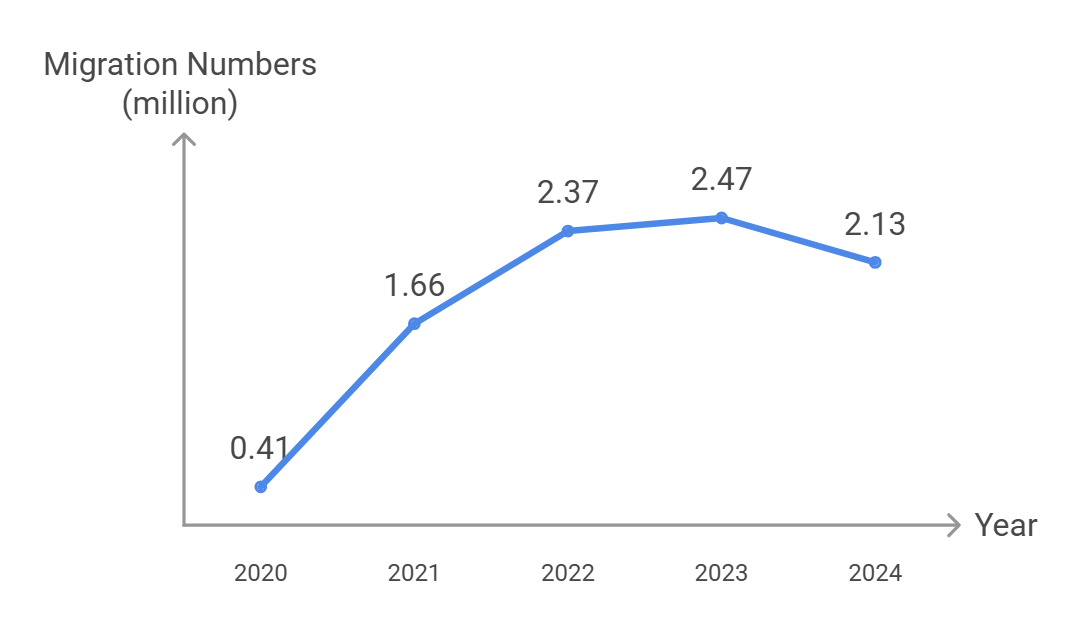In 2024, immigration trends to the United States shifted dramatically compared to previous years, primarily due to policy changes and increased enforcement at the border.
These shifts are particularly evident in data from U.S. Border Patrol and other official reports.
Both U.S. and Mexican government actions have significantly impacted asylum claims processing and the management of cross-border migration this year.
The numbers tell a story of decline from the previous year, reflecting a more controlled approach to immigration.
Let us take a look at all the details regarding the immigrants in the US, including how many of them entered the country in 2024.
Table of Contents
ToggleData on Immigrants in the US

In 2024, the enforcement encountered 2,135,005 immigrants at the border with Mexico. Even though this number is quite high, it is significantly lower than 2023, by 350,000.
The most noticeable change in 2024 has been the sharp decline in migrant encounters, especially when compared to the peak levels seen at the end of 2022 and 2023.
Migration numbers over the years, according to Statista and CPB.gov:

By August 2024, the U.S. Border Patrol recorded 58,038 encounters, a significant drop of 77% from the December 2023 peak of 249,741 encounters.
The sharp decrease can be attributed to policy changes in the United States, including stricter asylum rules, and Mexico’s enforcement of its immigration policies.
Reports suggest that Mexico’s role has been crucial in this shift, as the Mexican government increased enforcement measures, such as enhanced patrols and checkpoints, and agreements with the U.S. led to these stricter controls.
Although a 3% increase in apprehensions was noted in August 2024 compared to July, overall numbers remain far below 2023 levels.
As PewResearch suggests, the nationality breakdown of apprehended immigrants in the US shows that the most prevalent ones are:
| Country | December 2023 Encounters | August 2024 Encounters | Percentage Decrease |
|---|---|---|---|
| Mexico | 56,240 | 26,824 | 52% |
| Guatemala | 34,693 | 6,420 | 81% |
| Honduras | 18,993 | 4,465 | 76% |
| El Salvador | 5,818 | 2,076 | 64% |
Comparative Analysis of Border Crossings
Comparing border crossings under the Biden administration to previous years reveals a major shift in patterns.
As we can see in the BBC report, since January 2021, over 10 million migrant encounters (8 million crossed the border) have occurred at the U.S.-Mexico border, yet the numbers have fallen significantly in mid-2024.
The decline is attributed to new policies aimed at curbing mass migration, including an executive order issued in June 2024 by the White House, which introduced fast deportation processes when weekly migrant encounters exceeded a certain threshold.
Mexico’s collaboration in halving the crossings played a key role in stabilizing the situation as we pointed out earlier.
Unauthorized Immigrants in the United States
| Year | Unauthorized Immigrants Estimation |
|---|---|
| 2017 | 10,500,000 |
| 2016 | 10,700,000 |
| 2015 | 11,000,000 |
| 2014 | 11,100,000 |
| 2013 | 11,200,000 |
| 2012 | 11,200,000 |
| 2011 | 11,500,000 |
| 2010 | 11,400,000 |
| 2009 | 11,300,000 |
| 2008 | 11,700,000 |
| 2007 | 12,200,000 |
| 2006 | 11,600,000 |
| 2005 | 11,100,000 |
| 2000 | 8,600,000 |
| 1995 | 5,700,000 |
| 1990 | 3,500,000 |
According to the Pew Research Center, the population of unauthorized immigrants in the United States was estimated to be 11 million in 2022, marking an increase from 10.5 million in 2021.
The report from Migration Policy gives a more detailed insight into how the situation looks like in 2024:
| Countries of Origin | Estimate | Percentage |
|---|---|---|
| Mexico | 5,313,000 | 48% |
| El Salvador | 741,000 | 7% |
| Guatemala | 724,000 | 7% |
| India | 553,000 | 5% |
| Honduras | 490,000 | 4% |
| Regions of Birth | ||
| Mexico and Central America | 7,381,000 | 67% |
| Caribbean | 327,000 | 3% |
| South America | 907,000 | 8% |
| Europe/Canada/Oceania | 440,000 | 4% |
| Asia | 1,697,000 | 15% |
| Africa | 295,000 | 3% |
This growth reversed a long-term decline from 2007 to 2019 but remains below the peak of 12.2 million in 2007.
The unauthorized immigrant population is diverse, with individuals from Mexico comprising the largest group, although their numbers have significantly declined since 2007. Meanwhile, the populations from regions like the Caribbean, South America, and sub-Saharan Africa have seen notable increases.
Unauthorized immigrants include those without legal residence or citizenship but may encompass individuals under Temporary Protected Status (TPS), Deferred Action for Childhood Arrivals (DACA), or awaiting asylum decisions.
In 2022, unauthorized immigrants accounted for 3.3% of the total U.S. population and 23% of the foreign-born population. Despite challenges, many participate actively in the labor force, representing approximately 4.8% of the U.S. workforce.
Demographic Shifts in Migrant Populations
A closer look at the demographics of migrants in 2024 reveals notable shifts, as well as reasons why people emigrate to the US.
Traditionally, immigrants in the US from Mexico and the Northern Triangle countries (El Salvador, Guatemala, and Honduras) have dominated U.S.-Mexico border crossings.
- Venezuela
- Nicaragua
- Cuba
The makeup of migrant populations at the border also saw changes in terms of the composition of those traveling.
While the majority of migrants have historically been single adults, there has been a rise in families and unaccompanied minors seeking entry into the United States.
The conditions in their home countries, coupled with the tighter restrictions placed on asylum seekers, have created a more complex migrant profile.
Interesting Fact: Immigrants that come from South America go through a dangerous Darien Gap. Nowadays, the Government of Panama aims to close it.
Political and Social Implications

The issue of immigration remains a central topic in the 2024 U.S. elections, with political and social ramifications that extend far beyond the numbers.
Public opinion is deeply divided on the effectiveness of the border policies, with some praising the Biden administration for reducing the number of immigrants in the US and others criticizing the humanitarian impact of stricter rules.
If you look at the pools, you will see that for 80% of Americans the federal government does a bad job of controlling the border.
The debates around mass deportation, border security, and asylum reform have gained momentum, fueling election discourse across both major political parties.
These policies and their effects have also sparked protests and debates within various communities, as some argue that tighter restrictions create unnecessary hardship for asylum seekers.
On the other hand, proponents of stricter immigration policies, like Arkansas Senator John Boozman, emphasize the need for stronger border control to protect national security and manage resources.
These discussions will likely play a significant role in shaping future U.S. immigration policy, particularly in the context of the 2024 election campaign. It will certainly have an impact on the behavior of the swing states, no doubt about that.
Contrasting Approaches to U.S. Immigration: Trump vs. Biden
The immigration policies of former President Donald Trump and current President Joe Biden showcase two distinct approaches to managing border security, asylum, and legal immigration.
Both administrations faced significant challenges within the U.S. immigration system, but their strategies diverged widely in execution and philosophy.
| Trump’s Immigration Policies | Biden’s Immigration Policies |
|---|---|
| Physical Border Wall Construction | Halted Border Wall Construction |
| Zero-Tolerance Policy | Ended Zero-Tolerance Policy |
| “Remain in Mexico” Policy | Termination of “Remain in Mexico” Policy |
| Metering at Ports of Entry | Asylum Reforms |
| Asylum Restrictions | Family Reunification |
| Family Separation | Deportation Priorities |
| Legal Immigration and Parole | Expanded Legal Immigration and Parole |
NEW Trump vs. Biden on immigration: 12 charts comparing U.S. border security — with @mariasacchetti @sfrostenson https://t.co/KgRcRDie3k
— Nick Miroff (@NickMiroff) February 12, 2024
Methodology
Our analysis collects data on immigration to the United States in 2024 from multiple reputable sources, focusing on governmental reports, statistical databases, and authoritative research studies.
Official U.S. government databases, such as U.S. Customs and Border Protection (CBP.gov), provide regular updates on border crossings and immigration statistics, serving as the primary data sources.
Researchers used figures from the Statista platform to compare migration numbers over several years, offering a comprehensive view of immigration trends and fluctuations.
Reports from prominent research institutions, including the Pew Research Center and news outlets like the BBC, provide valuable insights into demographic shifts among migrant populations and contextualize the political and social ramifications of immigration trends in 2024.
To clearly show how 2024 compares to previous years, analysts conducted a comparative analysis using historical data from U.S. government reports and third-party research.
They evaluated data points from 2020 through 2024 to highlight significant changes in migrant encounters, evolving policies, and enforcement measures.
The Bottom Line
2024 has seen a notable decrease in immigrants in the US compared to the previous year, primarily due to government policies and enhanced border enforcement measures.
These changes reflect a more controlled approach to managing migration, and they will undoubtedly influence future trends in U.S. immigration.
As the 2024 election looms, the issue of immigration will remain a pivotal and contentious topic.
Sources
- Statista – Apprehensions and expulsions registered by the United States Border Patrol from the 1990 fiscal year to the 2023 fiscal year
- US Customs and Border Protection – Southwest Land Border Encounters
- PewResearch – Migrant encounters at U.S.-Mexico border have fallen sharply in 2024
- TandfOnline – Managing Irregularized Migration in Mexico: Rhetoric of a Renewed Approach
- WhiteHouse – President Biden Announces New Actions to Keep Families Together
- PewResearch – What we know about unauthorized immigrants living in the U.S.
- Migration Policy – Profile of the Unauthorized Population
- American Immigration Council – Temporary Protected Status: An Overview
- Council of Foreign Relations – Central America’s Turbulent Northern Triangle
- TheGuardian – Panama to shut down Darién Gap route in deal that will see US pay to repatriate migrants
- Boozman.Senate. – Urgent Need to Secure the Border
- USNews – How Much of Trump’s Border Wall Was Built?
- PBSNews – Biden administration ends Trump-era ‘Remain in Mexico’ policy
Related Posts:
- Why do Immigrants Come to the United States?
- How Many Guns Are in America in 2025? Looking Down…
- How Many WW2 Veterans Are Still Alive? Will There Be…
- How Many Navy Fleets Does the US Have in 2025?
- How Many Fighter Jets Are in the U.S. Military Fleet…
- What to Know About Physical Fitness Requirements for…







